When someone says “Pearl Harbor”, it can refer to many different things.
Historically, it was a large freshwater lagoon known to ancient Hawaiians as Ke-awa-lauo-Pu‘uloa or simply Pu‘uloa. It was a key site for loko ʻia (fish ponds) and for harvesting wild shellfish.
Today, Pearl Harbor is surrounded by suburban neighborhoods. Along her shores, there is also a National Memorial Park and an active U.S. military base. When people visit Pearl Harbor today, it is often to see relics of the December 7, 1941 attack, including the USS Arizona National Memorial, as well as a WWII submarine, a historic American battleship, and an aviation museum with a collection of vintage aircraft.
On a map of O’ahu, the large harbor off Malama Bay on the southwest coast resembles a giant tree with three trunks corresponding to three bays. These awalau (bays or lochs) are known as Kaihuopala‘ai (West Loch), Wai‘awa (Middle Loch) and Komoawa (East Loch). Pearl Harbor is located on the eastern shore of the East Loch.
We’ll start with the ancient history of Pu‘uloa and then describe the Pearl Harbor visitor attractions on and off the military base.
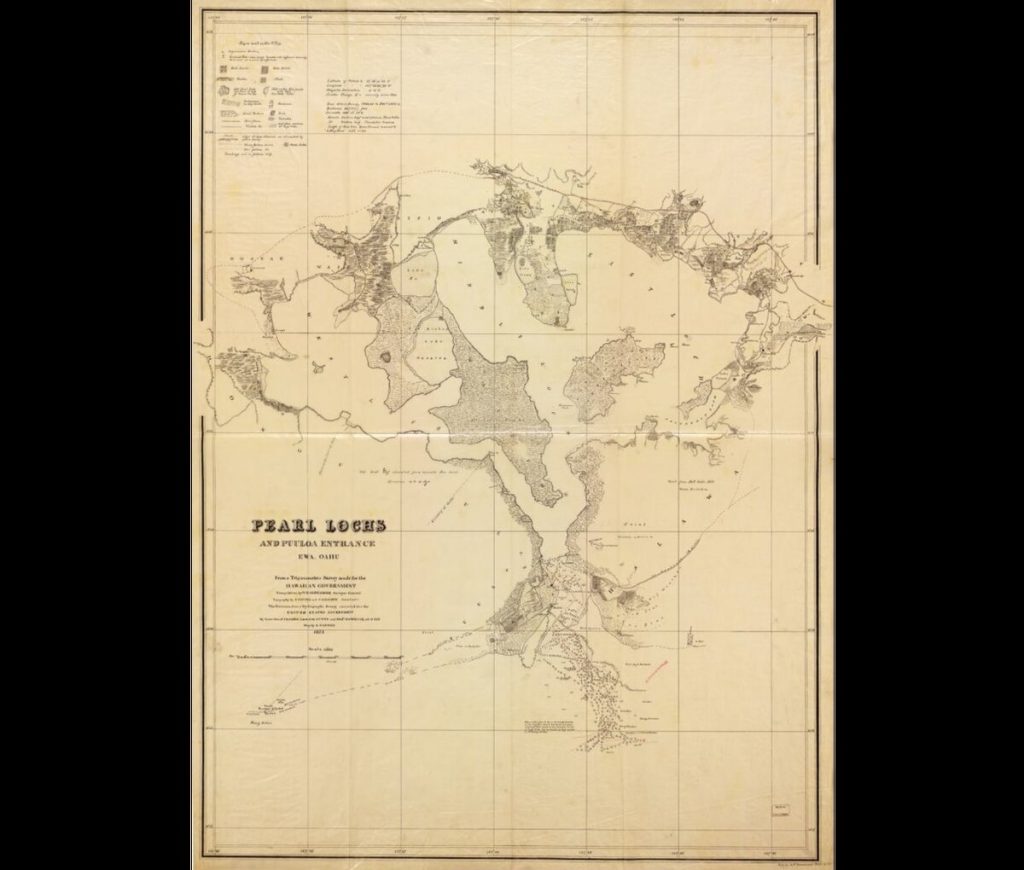
Lyons, C. J. & Lidgate, J. (1873) Pearl Lochs and Puuloa Entrance, Ewa, Oahu. [Map] Retrieved from the Library of Congress, https://www.loc.gov/item/2010587737/.
Ke-awa-lauo-Pu‘uloa
Once separted from the Pacific Ocean by a sand bar and coral reefs, the shallow bay located on the expansive ʻEwa plain between between the Waiʻanae and Koʻolau Ranges had several descriptive names:
- Wai Momi (“freshwater pearls”), because of the abundance of pipi or Hawaiian pearl oysters once harvested there (for food, not the pearls)
- Awawa-lei (“garland of harbors”)
- Ke Awa Lau O Pu`uloa (“the-many-harbors-of-long-hill”)
‘Ewa moku (district), more formally called Ke-‘Āpana-o-‘Ewa included all of the ahupua‘a (land divisions) that claimed a section of shoreline along Pu‘uloa. The moku was the political center of O‘ahu prior to defeat by Kamehameha I.
Puʻuloa was an important food resource for Hawaiian people who lived in ‘Ewa moku. They harvested several types of native shrimp and bivalves from the lagoon, as well as created loko iʻa (fish ponds) along her shores.
Hawaiian legend is steeped in stories about the lagoon. One key story tells about the goddess Ka’ahupahau and her brother Kahi’uka, who protected fishermen from man-eating sharks. Another reference to the area is “ke alahula o Kaʻahupahau” (the paths frequented by Kaahupahau), which refers to her vigilant protection of the people of Oʻahu.
Known for the abundant sealife, ʻEwa moku also supported cultivated crops on the plains around the harbor, primarily kalo (taro), yams, bananas, and kava. After the arrival of Europeans, this agriculturally rich land gave way to sugar cane and pineapple plantations.
In 1875, the Kingdom of Hawaiʻi and the United States of America ratified the Treat of Reciprocity, agreeing to duty-free shipments of products between the two countries. In 1887, the treaty was renewed and granted U.S. vessels the exclusive privilege of entering “Pearl River Harbor” and establishing a coaling and repair station.
While the trade agreement seemed favorable, it marked the beginning of a struggle for control of the Hawaiian Islands that lasted through three U.S. presidents. It was a protracted back-and-forth struggle between the Hawaiian Monarchy, Native Hawaiians, and white businessmen who sought to annex the islands to protect their financial interests, in particular, duty-free trade of their plantation crops.
Native Hawaiians initially succeeded in petitioning Congress to block annexation of the independent country. However, the group of white businessmen, which included lawyer Sanford B. Dole, forcibly overthrew the Hawaiian Kingdom, imprisoned Queen Liliʻuokalani, and forced her to abdicate. A provisional government was established in 1895 with Dole as president. The new “Republic of Hawaiʻi” set up a Constitution unfavorable to the interests of Native Hawaiians and again lobbied Washington to annex Hawaiʻi as a U.S. territory.
In 1898, the Spanish-American War broke out. Because Hawaiʻi was a strategic mid-Pacific location for U.S. troops in the Philippines, President McKinley signed the annexation treaty. Despite the illegal overthrow of the monarchy, and over the objection of Native Hawaiians, the Republic of Hawai’i was became a new American Territory of Hawai’i. (It is also interesting to note that Doles cousin, James came to Hawaii in 1899 and founded the Hawaiian Pineapple Company on Oʻahu. But that’s another story for another day.)
In 1908, the United States established a naval base at Pearl Harbor. To the outrage of Native Hawaiians, the natural coral reef at the entrance to the lagoon was removed. The channels were also dredged to accommodate large ships, increasing the depth from approximately 16 to 45 feet. Within a few years, barracks were built to house Marines and Army personnel.
In 1935, Hickam Airfield was constructed and by 1940 Pearl Harbor was established as the base for the U.S. Navy Pacific Fleet.
Today, neighborhoods west of Honolulu that border the west and middle lochs include Ewa, Waipahu and Pearl City (for reference, Kapolei is west of Ewa). Surrounding the East Loch are Waimalu, Aiea, the Pearl Harbor National Memorial Park, and a U.S. military base—immediately to the east is the Daniel K. Inouye International Airport. Downtown Honolulu and then Waikīkī are further to the east.
Pearl Harbor visitor attractions
Pearl Harbor National Memorial Park is located on the eastern shore of the East Loch, between Aloha Stadium to the north and the Honolulu International Airport to the east. Just beyond the National Park is the active U.S. military base. In 2010, Naval Station Pearl Harbor joined with nearby Hickam Air Force Base to become Joint Base Pearl Harbor-Hickam (JBPHH).
From Pearl Harbor National Memorial Park, civilians can access all the historic military sites listed here. Each visitor attraction is explained in more detail below.
- Pearl Harbor Visitor Center
- USS Arizona Memorial
- USS Bowfin Submarine Museum & Park
- Battleship Missouri Memorial
- Pearl Harbor Aviation Museum
First-time visitors to Pearl Harbor usually focus on seeing the USS Arizona Memorial, reached via a short boat ride from the Pearl Harbor Visitor Center. Although visiting the Arizona is free, the boat ride has limited capacity and therefore requires a ticket. Another attraction on the grounds of the National Memorial Park is the USS Bowfin Submarine, operated by the Pacific Fleet Submarine Memorial Association.
Not to be overlooked is the Visitor Center itself. The 17-acre site offers indoor and outdoor exhibits detailing many interesting facts and history about Pearl Harbor.
Two more attractions are located on JBPHH property. While the military base is mostly off-limits to civilians, a free shuttle from the Pearl Harbor Visitor Center to Ford Island (in the middle of the East Loch) takes you to the Battleship Missouri Memorial and the Pearl Harbor Aviation Museum.
Listed below are more details about visiting each of these Pearl Harbor attractions. After the individual sites, we also provide information about organized tours that encompass more than one site and can include transportation to and from Waikīkī hotels.
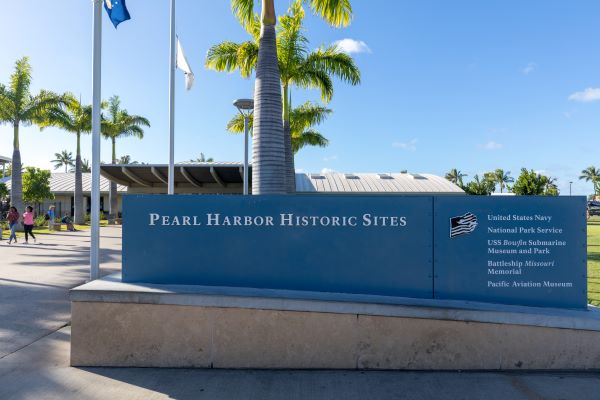
Pearl Harbor Visitor Center entrance – Depositphotos.com
Pearl Harbor Visitor Center
The Pearl Harbor area was designated a national historic landmark in 1964. Since 1980, the Pearl Harbor Visitor Center has been operated by the U.S. National Park Service. Admission and parking are free; reservations are not required. There is a lot to see and do at the 17-acre site, which was renovated and expanded in 2011.
Anyone can visit the National Memorial Park and visit the indoor exhibit galleries, watch the Park Film, walk the grounds on paved paths (suitable for strollers and wheelchairs), read fascinating facts on the outdoor wayside exhibits, enjoy scenic shoreline views, pay tribute to the fallen in the Remembrance Circle, and shop in the bookstore. For an additional fee, you can visit the Virtual Reality Center or with an audio tour.
- Address: 1 Arizona Memorial Place, Honolulu, HI 96818. If you search for “Pearl Harbor” on Google Maps, you will receive directions to the military base rather than the visitor center.
- Hours: open 362 days/year, closed Thanksgiving, Christmas, and New Year’s Day.
- General admission: free
- Parking: $7 (as if April 30, 2024)
- Bag policy: there is a strict no-bag policy, including purses, handbags, fanny packs, camera bags, diaper bags, etc. Bag storage is offered for a fee. However, the recommendation is to bring only items you can carry or that fits in your pockets.
- Website: https://www.nps.gov/perl/index.htm

USS Arizona Memorial – DepositPhotos.com
Visiting the USS Arizona Memorial
One of Hawai’i’s most visited attractions, the USS Arizona Memorial is a small structure on the east side of Ford Island, built over the remains of the legendary battleship. The Arizona Memorial honors those who died in the attack on December 7, 1941. The unique design of the memorial is easily visible across the channel from the visitor center.
The Arizona Memorial was designed by architect Alfred Preis. The stark white structure is a metaphor for the United States during WWII and represents pride, shock (and depression), and power. There is much more symbolism in the thoughtful design that you can learn during a tour, at the visitor center, or in books about the memorial.
The remains of the sunken World War II battleship contains the bodies of hundreds of soldiers who lost their lives during the attack on December 7, 1941. Because the ship was so severely damaged and their identities could not be confirmed, the decision was made to leave the crewmembers with their ship. The men are considered buried at sea.
Another WWII ship also remains sunken in Pearl Harbor on the opposite (west) side of Ford Island. The USS Utah contains the bodies of 54 crewmen, also considered buried at sea. The USS Utah Memorial is not included on any Pearl Harbor tour and can only be visited by those with Military ID.
The USS Arizona program includes a documentary on the history of Pearl Harbor, followed by a tour of the memorial that includes a short boat ride to and from the site. In addition, there are several indoor and outdoor exhibits. Plan to spend at least 1-2 hours seeing the memorial and longer if you become absorbed in war history.
- Address: 1 Arizona Memorial Place, Honolulu, HI, 96818. Boat tours operated by the Department of the Navy depart from the visitor center.
- Hours: open 362 days/year, closed Thanksgiving, Christmas, and New Year’s Day.
- General admission: free, however tickets are required regardless of age. More information below.
- Website: https://www.pearlharborhistoricsites.org/pearl-harbor/arizona-memorial
How to get USS Arizona Memorial tickets
There are several ways to get tickets: online, standby, walk-up, or via an organized tour:
- Online tickets: https://www.recreation.gov/ticket/facility/233338. Ticket reservations require a $1/ fee. Tickets become available 8 weeks (56 days) in advance or one day in advance. Tickets sell out fast.
- Stand-by ticket: while at the Visitor Center, you can ask a Park Ranger or Volunteer about the of standby seats. Of course, availability and wait times are never guaranteed. But you won’t know, if you don’t ask!
- Walk-up ticket: Last time we checked, walk-up reserved tickets were no longer available.
- Organized tour: Many companies operate tours that include a boat ride ticket to visit the Arizona Memorial. For more information, visit the Tours section below.

USS Bowfin Submarine – DepositPhotos.com
Visiting USS Bowfin Submarine & Park
Located adjacent to the Pearl Harbor Visitor Center, the Pacific Fleet Submarine Museum campus features the USS Bowfin WWII submarine, a museum, and outdoor artifacts. Admission includes audio guides.
The campus also offers amenities including a shaded patio, food service, gift shop, restrooms, and concessions.
- Address: 11 Arizona Memorial Drive, Honolulu, HI 96818
- Hours: open 362 days/year, closed Thanksgiving, Christmas, and New Year’s Day.
- General admission: $22/adult and $13/child (4-12). Military and kamaʻaina rates available with ID.
- Parking: $7
- Bag policy: there is a strict no-bag policy, including purses, handbags, fanny packs, camera bags, diaper bags, etc. Bag storage is offered for a fee. However, the recommendation is to bring only items you can carry or that fit in your pockets.
- Website: https://www.bowfin.org/
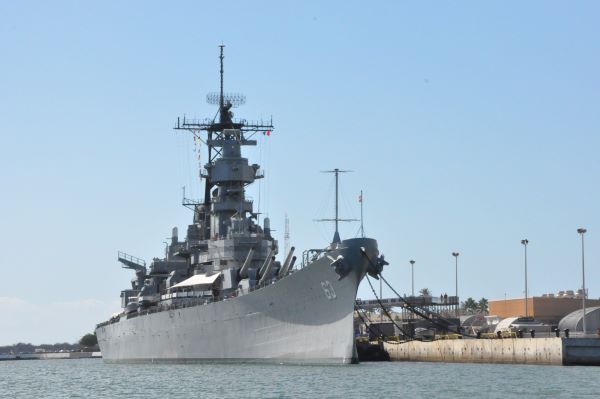
USS Missouri battleship at Pearl Harbor – DepositPhotos.com
Visiting the Battleship Missouri Memorial
USS Missouri, an Iowa class ship affectionately known as the “Mighty Mo” was the last American battleship ever built and the last to be decommissioned. Built in 1944, her career spanned five decades and five wars. On her deck, the surrender of the Japanese brought an end to World War II.
Admission includes a guided tour and/or self-guided tour map. The USS Missouri Memorial Association manages the attraction and is dedicated to preserving the Battleship Missouri and sharing her story and place in history.
The “Battleshop” offers a selection of snacks and cold drinks, although eating on board the ship is not allowed. However, there is a food truck outside with hot foods, snacks, cold beverages, shave ice, and pier-side seating. For gifts and memorabilia, shop the online store to support the Might Mo.
- Address: Ford Island, Pearl Harbor, 63 Cowpens St, Honolulu, HI 96818. Accessible only to those with active military ID. For all others, you need to take the free shuttle.
- Shuttle information: Free shuttles depart from the Pearl Harbor Visitor Center every 15-20 minutes. The last shuttle bringing guests to the ship departs at 2:45pm. The last shuttle returns to the Visitor Center at 4:05pm.
- Hours: open 362 days/year, closed Thanksgiving, Christmas, and New Year’s Day.
- General admission: $35/adult and $17.50/child (age 4-12). Military and kamaʻaina rates available with ID.
- Bag policy: there is a strict no-bag policy, including purses, handbags, fanny packs, camera bags, diaper bags, etc. Bag storage is offered for a fee. However, the recommendation is to bring only items you can carry or that fit in your pockets.
- Website: https://ussmissouri.org/
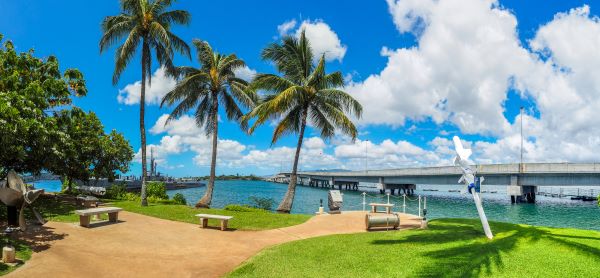
USS Bowfin Submarine (left) and bridge to Ford Island (right) at Pearl Harbor – Depositphotos.com
Visiting the Pearl Harbor Aviation Museum
View the battle-damaged airfield and control tower of historic Ford Island before setting foot inside the two WWII-era hangars that house the museum’s impressive collection of vintage aircraft along with artifacts and personal stories about life in Hawai’i in the 1940s, the impact of the December 7 attack, and more than 75 years of aviation history.
Enjoy a quick bite in the air-conditioned WWII-themed Café and shop in the museum store for collectibles and souvenirs.
- Address: Hangar 37, Ford Island, 319 Lexington Boulevard, Honolulu, HI 96818. Accessible only to those with active military ID. For all others, you need to take the free shuttle.
- Shuttle information: Free shuttles depart from the Pearl Harbor Visitor Center every 15-20 minutes. The last shuttle bringing guests to the museum departs at 3:45pm. The last shuttle returns to the Visitor Center at 5:00pm.
- Hours: open 362 days/year, closed Thanksgiving, Christmas, and New Year’s Day.
- General admission: $26/adult and $15/child (age 4-12). Tour upgrades are available at additional cost. Military and kamaʻaina rates available with ID.
- Website: https://www.pearlharboraviationmuseum.org/
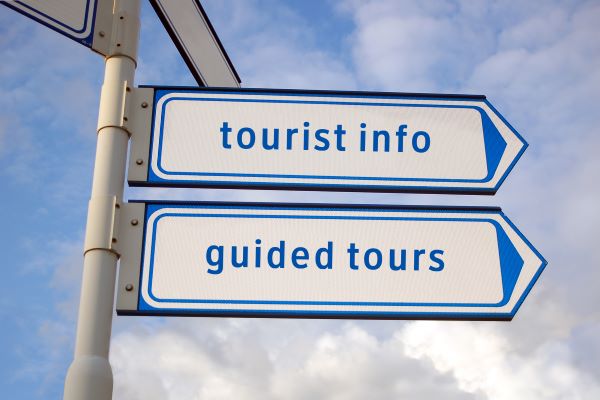
Many companies operate tours that include a boat ride ticket to visit the Arizona Memorial – Depositphotos.com
Tours of the USS Arizona Memorial
The primary reasons to book a tour for the USS Arizona Memorial through a tour company is to include transportation from your hotel and to guarantee a boat ride ticket to the Arizona Memorial. These tours begin around $50 per person and go up from there.
Tour cost depends on several factors, such as: total duration of the tour and number of stops, admission fees for other sites, more deluxe transportation or VIP amenities, and other options. If the USS Arizona Memorial is one of your “must see” attractions, make sure the tour you buy includes a boat ride ticket.
To save money, here are some other options, especially to see the USS Arizona Memorial via the boat ride:
- If you have a reserved ticket for the boat ride and can drive to the Visitor Center, parking is free. If you don’t have a car, public transportation via TheBus is $5.50 round-trip and takes about one hour from Waikīkī.
- If you don’t have a reserved boat ride ticket, you can drive or take TheBus to Pearl Harbor and ask for a standby ticket to the USS Arizona Memorial.
- If you can’t get a boat ticket, you can still tour the Visitor Center indoor and outdoor exhibits, which includes thorough information about the December 7, 1941 and a view of the memorial from across the water.
When you travel to Pearl Harbor by car or bus, you have the option of visiting any of the three other historic sites at Pearl Harbor, including the USS Bowfin Submarine Museum & Park, which is adjacent to the Visitor Center. Or, catch the free shuttle to Ford Island and visit the Battleship Missouri Memorial and Pearl Harbor Aviation Museum. Each of these sites has a separate entrance fee of $20-$30 per person. It is recommended to allow 1-2 hours per attraction for a thorough visit.
- Personally, I find it tiring to visit more than two sites per day, since I like to read the details. But some people like to breeze through in 30 minutes and catch only the highlights. Whatever your preference, budget your time and dollars accordingly.
Listed below are some of the primary companies offering Pearl Harbor tours that include a ticket for the boat ride to the USS Arizona Memorial. Most offer several types of tours, read the descriptions carefully to confirm what is included. The companies are arranged in order from least to most cost for Arizona Memorial tours.

Navy shuttle boat going to the USS Arizona Memorial in Pearl Harbor – iStock by Getty Images
E Noa Tours
E Noa Tour drivers are locals and some of the best tour guides on the island certified in Hawaiiana. They offer several Pearl Harbor tours. All include the USS Arizona boat ride, plus other attractions and stops.
- Price: $57 and up
- Website: https://enoa.com/
Pearl Harbor Tours (pearharbor.org)
Pearl Harbor Tours is a private company with tours that include the USS Arizona boat ride with transportation to and from Waikīkī hotels and other locations around O’ahu. Also offers private tours with pickup at locations around Oʻahu, which can be a good option for large families, wedding parties, and other groups.
- Price: $57 and up
- Website: https://pearlharbor.org/pearl-harbor-tours/
Pearl Harbor Historic Sites tours (pearlharborhistoricsites.org)
Pearl Harbor Historic Sites is another private company and offers a “passport” to all sites listed above.
- Price: $90 per person
- Website: https://www.pearlharborhistoricsites.org/tickets-and-tours
Roberts Hawaii
Roberts Hawaii is Hawaii’s largest employee-owned tours and transportation company, which began in 1941 on Kauaʻi. Roberts now operates tours on four islands: Oʻahu, Maui, Kauaʻi, and Hawaiʻi Island (aka “Big Island”). They offer a large range of tours on each island from shopping excursions to water activities and surfing lessons, luau shows, and other entertainment. Roberts lowest price tour includes a stop at Pearl Harbor. There are several other higher priced tours with more sites.
- Price: $69 and up.
- Website: https://www.robertshawaii.com/oahu-tours/
Discover Hawaii Tours
Discover Hawaii several different tours that include a visit to Pearl Harbor and the USS Arizona, plus other sites or stops, such as a full day at Pearl, or visits to the North Shore or Aloha Swap Meet, or a circle island Oʻahu tour.
- Price: $59 and up
- Website: https://www.discoverhawaiitours.com/hawaii-tours-by-island/oahu-hawaii-tours/
Airfare vacation packages
Vacation packages booked through an airline that include airfare, hotel, and/or car rental may also include other options such as a Pearl Harbor tour. You can save more money by booking through a discount travel site, however, I prefer to book directly via an airline and then add on hotel and car rental via their package offerings.
